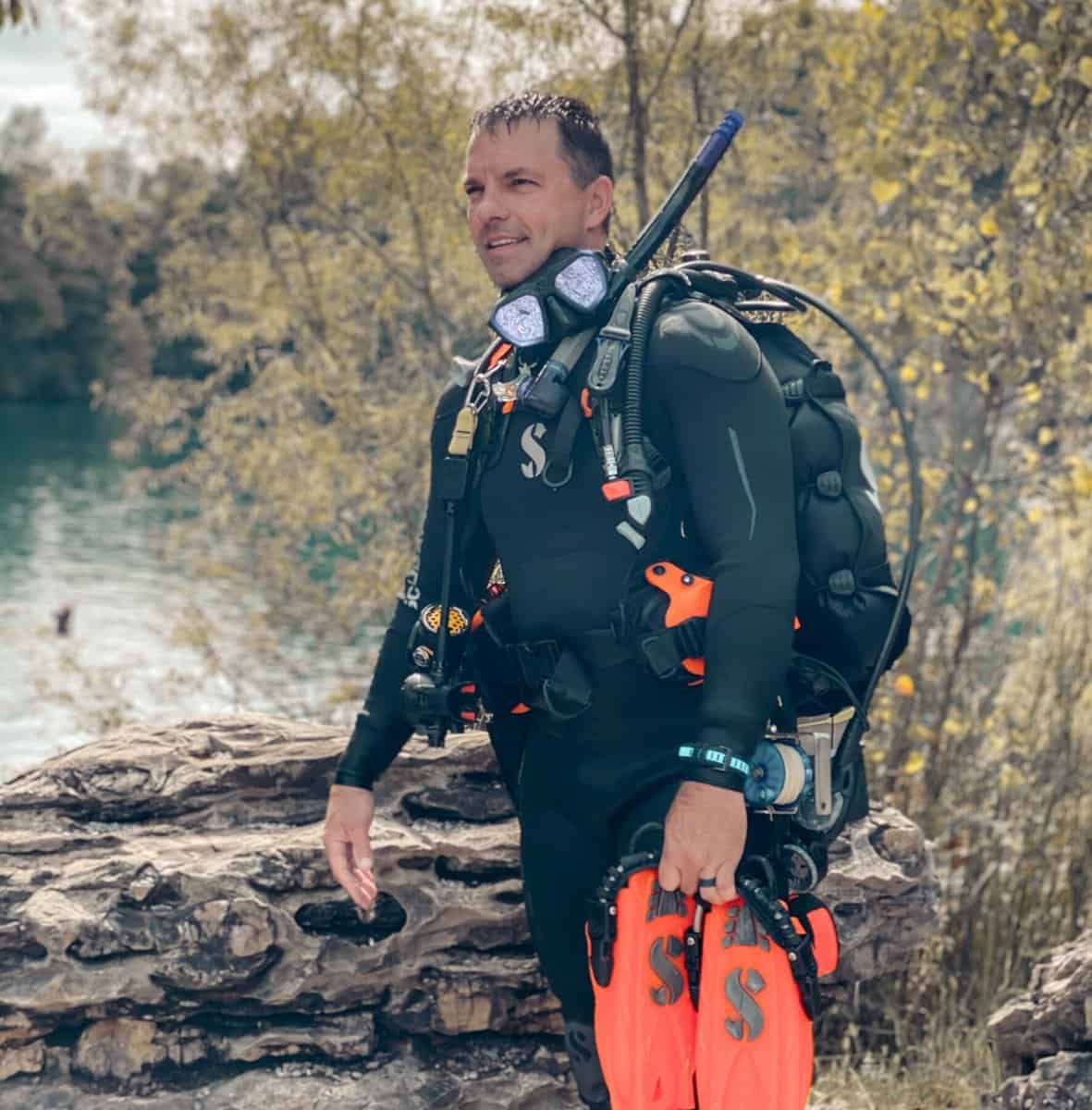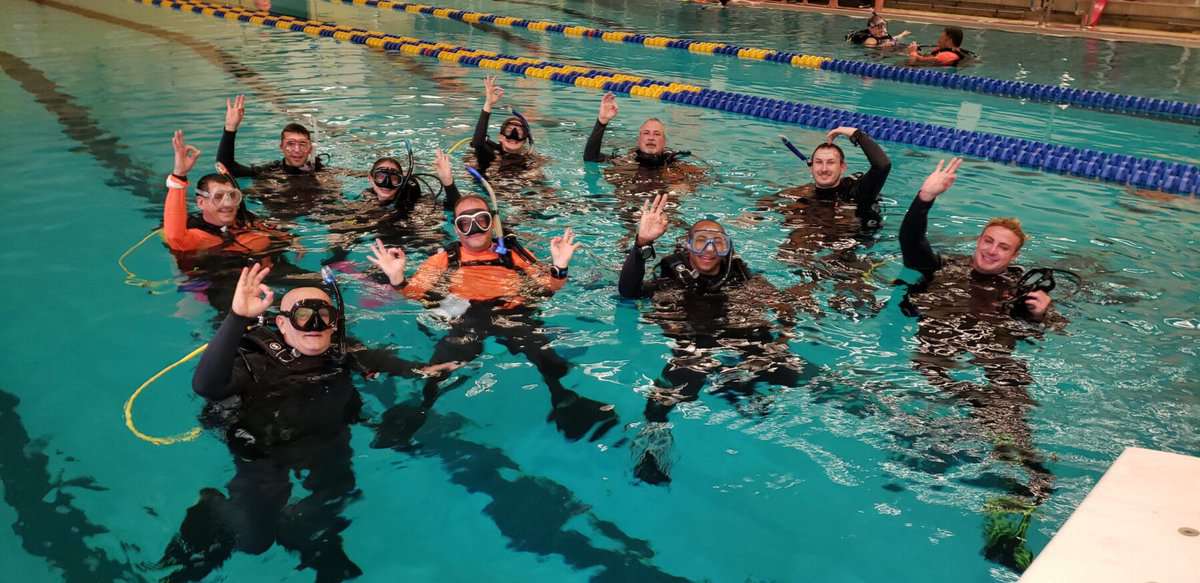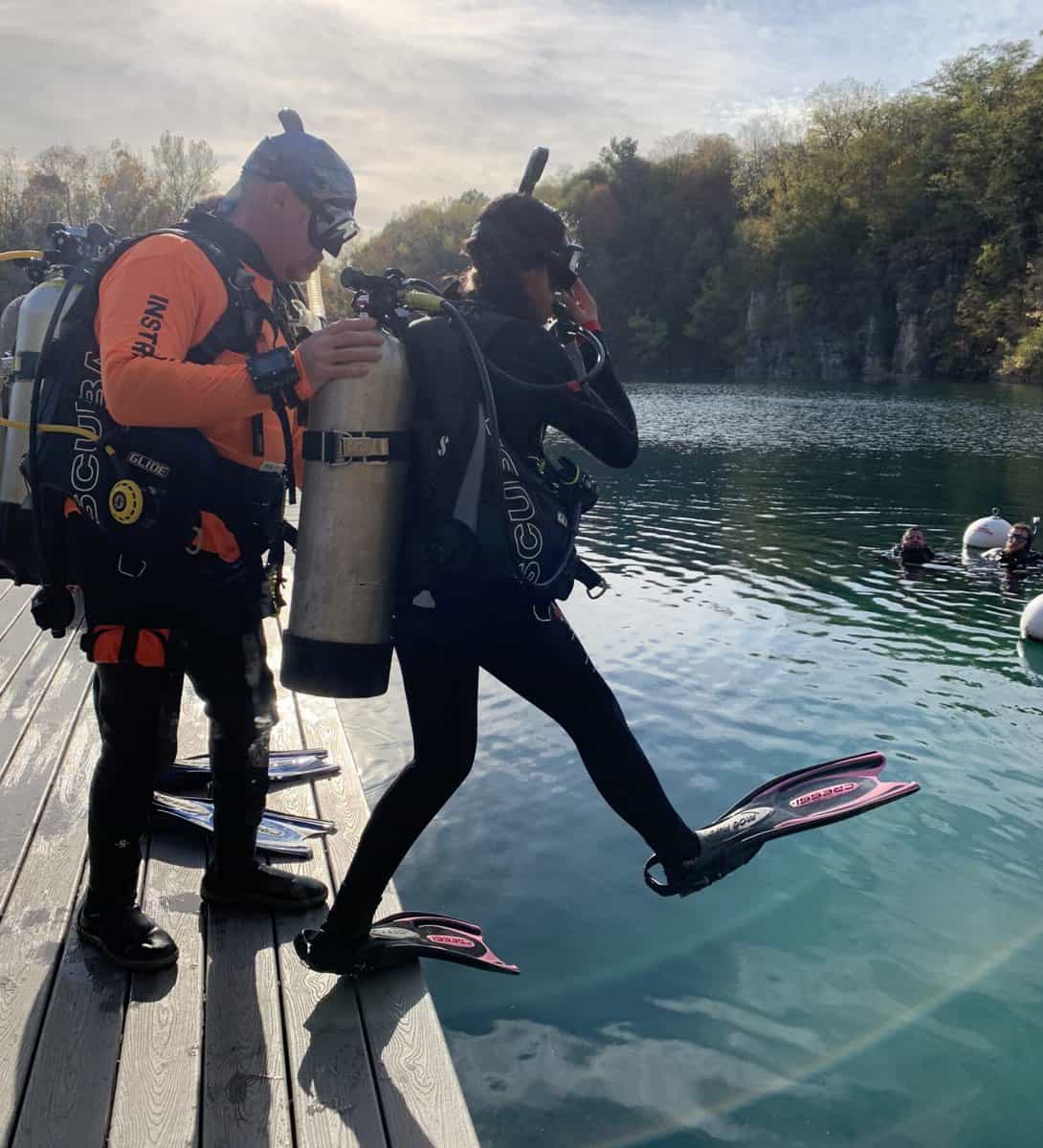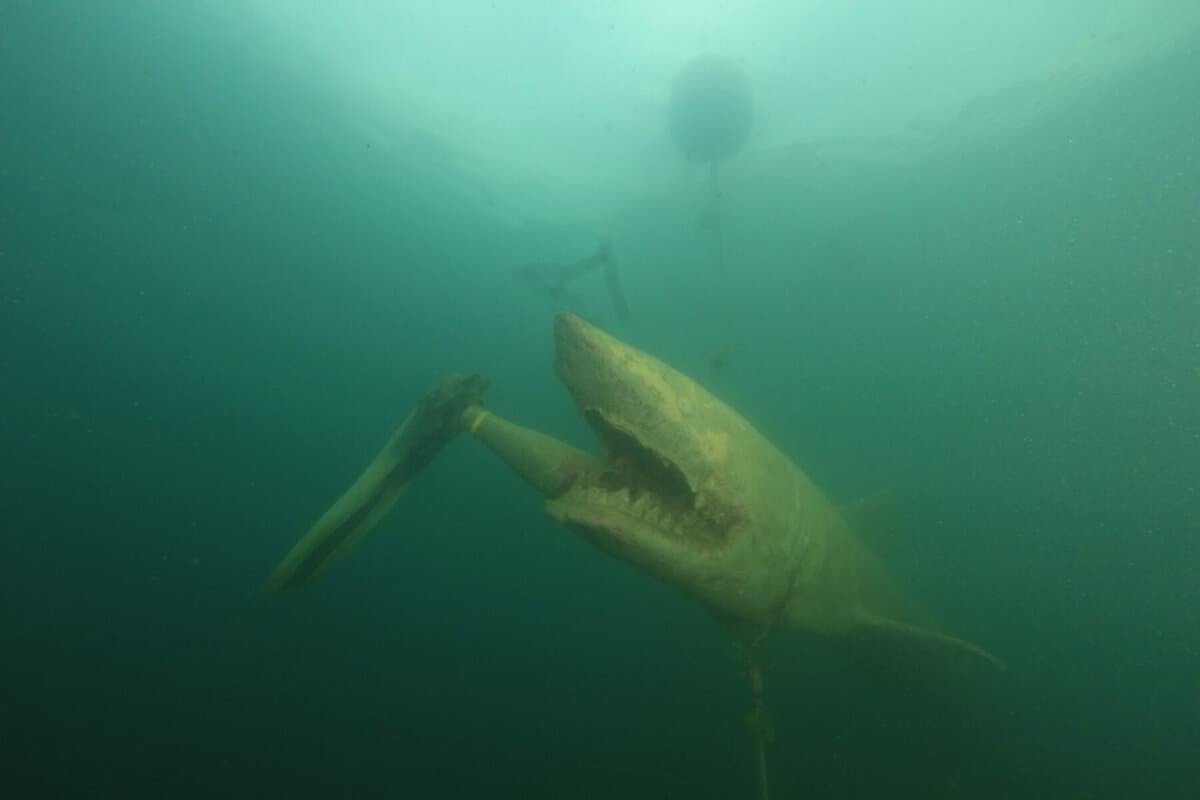As our boat motored away from shore, I looked back at the tree-lined coast of Montserrat, a tiny island in the south Caribbean. Sooner than expected, I’d be taking my first-ever plunge here with Troy Deppermann of Green Monkey Dive Shop (sadly, now closed). A fellow St. Louisan who had relocated to the “Emerald Isle of the Caribbean” a year earlier, Deppermann had helped me arrange a Discover Scuba Diving experience the day before, during which a local PADI instructor explained the basic scuba skills and let me blow bubbles around the resort pool for 45 minutes.
But now, things were about to get real.
We dropped the hook in Rendezvous Bay off of Montserrat’s single white-sand beach, geared up, and made the giant stride entry. At first, I had trouble equalizing my ear pressure as we swam down the anchor line, and we re-surfaced so Deppermann could give me some tips. Then, ears popped and problem solved, we went deep. Down below, we saw a spotted moray eel partially hidden in a cave formed by a pile of rocks. Sea fans and brain coral created a fairy-tale forest dotted with large barrel sponges. A flying gurnard spread its colorful wings like a subaquatic butterfly and soared over the sandy bottom.
The dive sites of Montserrat, while not endowed with the jaw-dropping walls or massive reefs of some Caribbean destinations, feature volcanic rocks that form the base of patch reefs covered by soft sponges and coral. Because there’s little shoreline development to contend with here, the undersea flora and fauna are free to flourish. And they do. On the way back to shore, Deppermann pointed out one of the island’s most unique dive sites, a series of partially submerged caves where he said it’s possible to dive beneath thousands of fruit bats.
Next time, I thought to myself.

Like a lot of us, I’d dabbled in snorkeling while visiting places like the Florida Keys and the Bahamas, but this was my first experience with scuba diving, and one that sparked a long-standing interest in the sport. Finning 30 feet below the surface, calmly exploring the alien ecosystem as goggle-eyed creatures cruised by to check me out — it was simply a different world. The mental snapshot I took away from Montserrat is of a green turtle flying lazy circles around us like a jetliner in a holding pattern. As I intermittently run through my mental reel of outdoor adventures, it always sticks out as a timeless, magical encounter.
And so, a little over 15 years later, I finally signed up to get my Open Water Diver certification with Y-kiki Divers, a PADI Instructor Development Center in St. Louis.
There are other recreational scuba diving certification bodies, including SSI and NAUI, and most share similar standards of practice. There are also other scuba instruction providers in St. Louis, such as West End Diving and Midwest Scuba. I chose PADI and Y-Kiki because of their five-star reputation and because the store locations in South County and Chesterfield, where I would take my classroom session and pick up my rental gear, were close by.
Earning your Open Water Diver certification isn’t overly difficult, but it does require time and effort — about 10 to 15 hours of online learning and two weekends of diving. Anyone aged 10 years or older in good health, reasonable fitness, and comfortable in the water can get certified as long as they successfully complete the three phases: knowledge development, confined water dives, and open water training dives.
Following is a brief recounting of my experience with Open Water Diver certification: the ups and downs, seen with fresh eyes, enthusiasm, and a touch of positive nervousness.
—
Student Diver’s Log — Day 1: Finished my online learning via the PADI website over five nights. The Four E’s Philosophy, pressure gauges, dive tables, emergency decompression stops, BCDs…gas narcosis? Well, at least that one sounds fun.
Today is the first session of my PADI scuba certification. We (eight students, and four instructors) gather at Y-kiki’s South County store, where we try on wetsuits and then sit down in the shop’s classroom to review what we absorbed during elearning. “What you’re doing is serious,” says our lead instructor, Leslie Sawyer, “and it’s important. Don’t let go of that.” We take the final requisite quiz, which thankfully everyone passes.
It’s warm and sunny outside on this Saturday morning, and we’re all itching to bust out of the store and make a break for the water. We’re handed our rental gear, stuffed inside mesh scuba duffels for easy transport, and we work on connecting and disconnecting the buoyancy compensator device (BCD), regulator sets, and scuba tank multiple times before getting cut loose for lunch.

Confined water dive class. (Y-kiki Divers)
Afternoon, and it’s time to practice what our instructors preached this morning. We slip into the pool at Principia School in Town & Country, and Leslie demonstrates skills, which we repeat. We practice partial mask flooding and clearing, regulator recovery, controlled ascents and descents, and hand signals. I wonder what the hand signal is for “hey, that guy elbowed me,” as we’re often bouncing off each other in the confines of the pool. But it’s all part of learning spatial awareness and control. “Scuba is a contact sport,” jokes Fritz Mihelcic, a divemaster lending a hand.
I’m also annoyed by (read: envious of) one of my 15-year-old classmates. The lanky kid sails through everything the first time. He has to be part fish. One of the other teenagers in our group, though, is struggling with some of the skills as they get harder. Leslie is Mother Teresa patient. She calms the girl down and works with her one on one, quick to reward with a fist bump and big smile. Soon, we’re all back on track.
We finish three dives this afternoon, the skills progressing to mask removal and replacement, BCD oral inflation, controlled emergency ascent, and octopus breathing (which isn’t as slimy as I feared). We have two more pool dives scheduled for tomorrow morning, Day 2, then we take things outside.
—
Student Diver’s Log — Day 3: Y-kiki holds its open water training dives at Mermet Springs, an ideal venue for my quest. Situated in the countryside between Vienna and Metropolis, Illinois, about three hours from St. Louis, there are few distractions. You’re there to dive or to learn to dive.
Excited to start open water dives, but also have some butterflies. There are four of us today, and Leslie and Fritz have been replaced by Cindy Schroeder and Nick Atherton. We set up shop at one of the waterside training pavilions. It happens to be Women’s Dive Day, and Mermet is heavy with people in pastel tech shirts. For $50, you get some branded souvenirs and the chance to win prizes with an underwater scavenger hunt. “I’m just looking for a woman whose red flag has a white stripe on it,” says one of our neighbors.
We pair up and gear up. Nick makes sure we perform our safety checks early and often. Then, my dive buddy and I lumber down to the dock like two Frankensteins wearing 40-pound backpacks. Let’s dive! Cindy, though, is a tease. She gives us a glimpse of the spring-fed former quarry and its numerous underwater attractions but then leads us to a training platform 20 feet down to do more skill work.

Stepping in a Mermet Springs. (Y-kiki Divers)
Achieving weightlessness, neutral buoyancy in scuba terms, is my biggest challenge. Adding just the right amount of air to my BCD, controlling the pace of my breathing (as well as how deeply I inhale and exhale), remaining stationary inches above the submerged platform — it’s tricky. Cindy and Nick, of course, levitate like natural-born astronauts in zero gravity. But I eventually get the hang of it. “I practice neutral buoyancy every time I dive,” says Nick back on dry land. “It’s important because it will keep you off the bottom, so you’re not bashing coral or stirring up sediment.”
We zip through two morning dives, break for a burger at Mermet’s snack shack, then finish with one more dive in the afternoon. Each lasts about 30 minutes. The skills are mostly review, except for underwater compass navigation, which isn’t too different from what I’ve done at local adventure races. We get some time at the end of each dive to explore the lake together. Good visibility (up to 60 feet) and water temperatures in the 70s above the thermocline. When we log each session on the PADI app, it asks, “How did you feel about this dive?” My answer: “Amazing.”
Before heading back to my Airbnb cabin for the night, we meet up for drinks and dinner at The Diver Down in Golconda. Nautical bric-a-brac, saltwater fish tank, Landshark beer in the cooler. It’s all perfectly on point.
—
Student Diver’s Log — Day 4: We, the students, get to plan our final open water dive. No training this time, just the real thing. There are literally planes, trains, and automobiles to see down below. I feel ready…that is, if the four of us can agree on a route.
Above the water, Mermet is surrounded by tall trees and sheer cliffs that rise from the cool-blue water. Beneath the surface, it features 30+ sunken attractions spread across 8.5 acres at depths from 15 to 120 feet. (Editor’s note: Unless you’re undergoing instruction, a dive certification card is required. The diver’s daily use fee is $25.)
At 20 feet, the lakebed is as lively as a fashion show catwalk. Schools of big bluegill weave back and forth on the underwater platform where we meet up. Other divers drop in from above. I’m so distracted watching all the activity that I almost miss Cindy’s beckoning. She leads us south along a guideline to a slime-covered school bus, then west to a suspended Cessna and, beyond that, an old ambulance and fire truck.
Even though I know our destination, I’m still a little surprised as the tail of a Boeing 272 materializes out of the murk. It’s reportedly the same plane used in the movie “U.S. Marshals,” and rumor has it that Mermet’s owner, Glen Faith, bought it for $1 and then sank it. We swim down the angled fuselage, through a couple of temperature changes, and peer inside the open cockpit at 45 feet. No Tommy Lee Jones or Wesley Snipes in here.

“Bruce” the shark at Mermet Springs. (Y-kiki Divers)
Around the shelf rock wall of the quarry to the east, we look for paddlefish in their favorite feeding ground but come up empty. No worries, we have plenty more to see: a submersed cabin cruiser and semi truck, a “petting zoo” with live crappies and plastic alligators. You’d think I’d be scared to encounter a giant animal that can eat me, but “Bruce” the shark (statue) doesn’t hold the same power.
It’s not exactly Montserrat, but Mermet Springs is just what I had in mind when I signed up to earn my Open Water Diver certification. And I know there’s a lifetime of subaquatic adventures ahead of me. I’ve been welcomed into a new community of diving friends, and with PADI and Y-kiki, I can keep learning through advanced courses and take trips to incredible places around the globe and close to home. It’s a different world beneath the surface, and I can’t wait to see what I discover next.
Midwest Dive Sites
Bonne Terre Mine in Bonne Terre, Missouri, is said to be the world’s largest freshwater scuba venue, attracting divers from all over the world. It offers group outings of up to 12 people during which you’ll explore three dive trails per trip — the mine has more than 50 trails overall. Since Bonne Terre is an abandoned lead mine, there are tons of interesting things to see, including ore cars, machine shops, dynamite cases, and even a locomotive.
Bull Shoals Lake in Bull Shoals, Arkansas, is an artificial lake in the Ozarks with 200-foot rock walls and 1,050 miles of shoreline to explore. More than 12 mapped dive sites around the lake include structures such as caverns, underwater forests, long gravel points, sunken farm implements, boats, and a destroyer escort. Fish friends in this body of water include walleye, crappie, catfish, gar, carp, and drum.
Pennyroyal Dive Center in Hopkinsville, Kentucky, is a beautiful, 22-acre rock quarry best known for its unusually clear and warm water. The dive park started with a single attraction back in 1994: its 1941 Dodge fire truck has been a staple attraction for nearly three decades. Over the years, more items have been acquired for dive attractions, including a yacht wreck, sunken motorhome, bus and more.
For more of the Midwest’s top dive sites, visit terrain-mag.com/midwest-scuba-sites.
Author: Brad Kovach is the editor/publisher of Terrain Magazine.


Leave A Comment